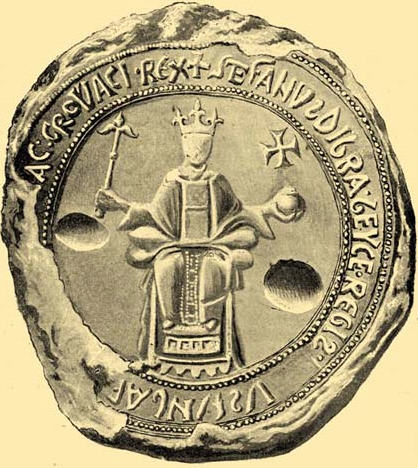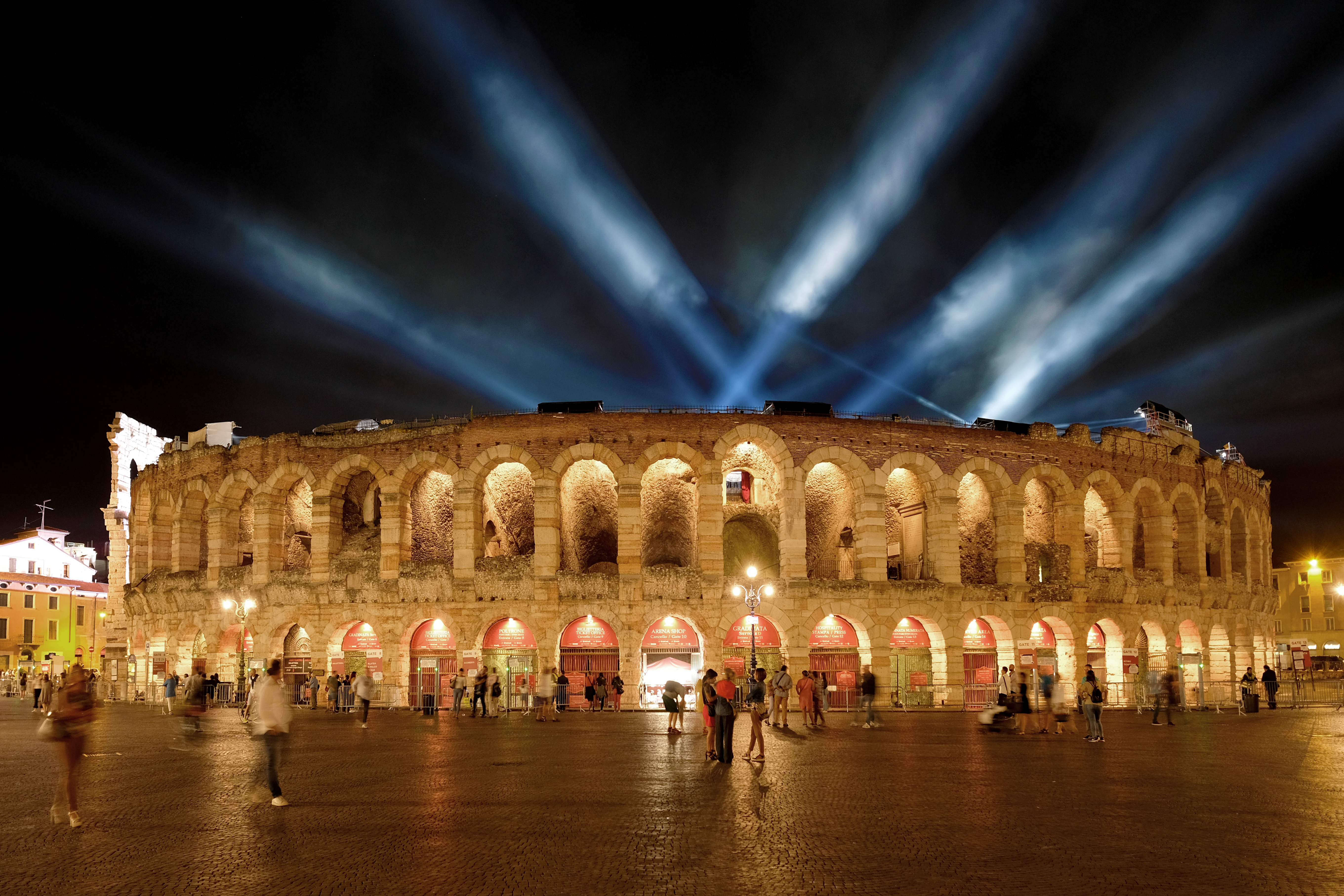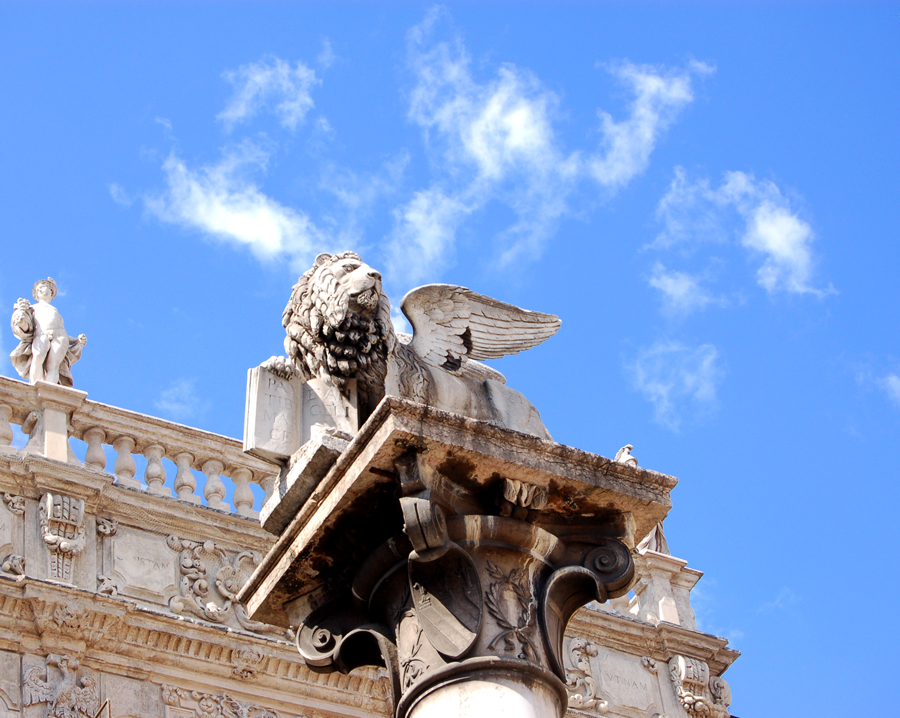|
1117
Year 1117 ( MCXVII) was a common year starting on Monday of the Julian calendar. Events By place Europe * January 3 – 1117 Verona earthquake. The earthquake is rated at VII (''Very strong'') on the Mercalli intensity scale, and strikes northern Italy and Germany. The epicentre of the first shock is near Verona, the city which suffers the most damage. The outer wall of the amphitheatre is partially felled, and the standing portion is damaged in a later earthquake of 1183. Many other churches, monasteries, and ancient monuments are destroyed or seriously damaged, eliminating much of Verona's early medieval architecture and providing space for a massive Romanesque rebuilding. * King Stephen II of Hungary regains Dalmatia from the Republic of Venice while the Venetians are on a naval expedition. Doge Ordelafo Faliero dies in battle (near Zadar) against the Hungarians. Faliero is succeeded by Domenico Michiel, who reconquers more territory and agrees to a 5-year truc ... [...More Info...] [...Related Items...] OR: [Wikipedia] [Google] [Baidu] |
1117 Verona Earthquake
An earthquake, rated at IX (''Violent'') on the Mercalli intensity scale, struck northern Italy and Germany on 3 January 1117. The epicentre of the first shock was near Verona, the city which suffered the most damage. The outer wall of the Verona Arena partially collapsed, and the standing portion was damaged in a later earthquake of 1183. After the first shock of 3 January, seismic activity persisted for months, striking on 12 January, 4 June, 1 July, 1 October, and 30 December. Geology The earthquake, estimated at magnitude 6.5–7.0, was the largest in northern Italy. Its effects in the Verona region was devastating. The assigned maximum intensity on the MCS scale was IX. Damage in southern Germany and Pisa were initially attributed to this single event in the works of early scholars, however, they are now widely accepted that three distinct earthquakes occurred within the span of several hours. The first earthquake affected the towns of Augsburg, Dissibodenberg, Freising, ... [...More Info...] [...Related Items...] OR: [Wikipedia] [Google] [Baidu] |
Ordelafo Faliero
Ordelafo Faliero de Doni (or ''Dodoni''; died 1117 in Zadar, Kingdom of Hungary) was the 34th Doge of Venice. Biography He was the son of the 32nd Doge, Vitale Faliero de' Doni. He was a member of the Minor Council (''minor consiglio''), an assembly formed from members of the so-called "apostolic families" that, in oligarchical Venice, assumed the governmental functions of judges, military councilmen, ambassadors and heads of state. His first name, which is otherwise unknown in Venetian history, is thought to have been derived from a backwards spelling of the Venetian name "Faledro", or from the Ordelaffi family, of which the Faliero family is thought to be a lineage. In 1105 the new Croatian king, Coloman of Hungary, enabled by the alliance to the Byzantine Emperor Alexios I Komnenos, launched campaign against Venetians, and returned the northeastern Adriatic coast under the crown. In 1106, a terrible flood happened in Venice. On the island of Malamocco, the old capit ... [...More Info...] [...Related Items...] OR: [Wikipedia] [Google] [Baidu] |
Vladislaus I, Duke Of Bohemia
Vladislaus I (; – 12 April 1125) was Duke of Bohemia from 1109 to 1117 and from 1120 until his death. Life Vladislav I was a son of Vratislaus II of Bohemia by his second wife Svatava, a daughter of Casimir I of Poland. Together with his cousin Svatopluk, Vladislav expelled his brother Bořivoj II from Bohemia in 1107. In 1109, Svatopluk was killed during a campaign in Poland, and Vladislav I succeeded him as Duke of Bohemia. Bořivoj II returned from exile with the support of Prince Bolesław III Wrymouth of Poland, but was defeated and imprisoned by Vladislav in 1110. In spite of his victory, Vladislav I remained under Polish pressure and was forced to recognize a younger brother, Soběslav, as subordinate ruler of Moravia in Znojmo. In 1117, Vladislav I formally abdicated in favor of Bořivoj II, but retained much of the actual power. In 1120, Bořivoj was deposed again and endowed with Znojmo, while Vladislav resumed the throne, which he held until his death in 1125. ... [...More Info...] [...Related Items...] OR: [Wikipedia] [Google] [Baidu] |
Bořivoj II, Duke Of Bohemia
Bořivoj II ( 1064 – 2 February 1124) was the duke of Bohemia from 25 December 1100 until May 1107 and from December 1117 until 16 August 1120. He was the younger half-brother and successor of Bretislaus II. His father was Vratislav II of Bohemia, his mother Świętosława of Poland. Life He was originally opposed by Duke Ulrich I of Brno, his cousin, who had recovered the stronghold originally confiscated from his father. A civil war ensued. Oldřich intended to recognise the suzerainty of Emperor Henry IV, and thereby gain his support, but Bořivoj had already been confirmed by the emperor. Oldřich was eventually forced to flee to Moravia. In 1102, Ladislaus I Herman, Duke of Poland, died. A quarrel broke out in Poland over the succession, with Bořivoj and his cousin Svatopluk supporting Zbigniew against Bolesław III Wrymouth. Bolesław, however, paid Bořivoj off and the latter withdrew from the conflict. Svatopluk, furious, defected and led a number of Bohemian g ... [...More Info...] [...Related Items...] OR: [Wikipedia] [Google] [Baidu] |
Almoravid Dynasty
The Almoravid dynasty () was a Berber Muslim dynasty centered in the territory of present-day Morocco. It established an empire that stretched over the western Maghreb and Al-Andalus, starting in the 1050s and lasting until its fall to the Almohads in 1147. The Almoravids emerged from a coalition of the Lamtuna, Gudala, and Massufa, nomadic Berber tribes living in what is now Mauritania and the Western Sahara, traversing the territory between the Draa, the Niger, and the Senegal rivers. During their expansion into the Maghreb, they founded the city of Marrakesh as a capital, . Shortly after this, the empire was divided into two branches: a northern one centered in the Maghreb, led by Yusuf ibn Tashfin and his descendants, and a southern one based in the Sahara, led by Abu Bakr ibn Umar and his descendants. The Almoravids expanded their control to al-Andalus (the Muslim territories in Iberia) and were crucial in temporarily halting the advance of the Christian kingdoms in ... [...More Info...] [...Related Items...] OR: [Wikipedia] [Google] [Baidu] |
Domenico Michiel
Domenico Michiel (died ) was the 35th Doge of Venice from 1116 or 1117 to his resignation in late 1129 or early 1130. In August 1122 Domenico Michiel led a Venetian fleet of 100 vessels and around 15,000 men for the campaign in the Holy Land. The fleet sailed under the flag of St. Peter, which the Pope had sent to Michiel. Over the winter the fleet set siege to the Byzantine island of Corfu. The siege was cancelled in the spring when news arrived that King Baldwin II of Jerusalem had been captured by the Artuqids, and that the Kingdom of Jerusalem had subsequently been invaded by the Fatimids of Egypt. The Venetian fleet went to the defence of Jerusalem and defeated the Egyptian fleet off of the Syrian coast. The Venetians then landed at Acre; from there Michiel went to Jerusalem, where the '' Pactum Warmundi'' was signed granting Venice privileged trade concessions, tax freedoms, and even partial ownership of some cities within the Kingdom of Jerusalem. On the return journey ... [...More Info...] [...Related Items...] OR: [Wikipedia] [Google] [Baidu] |
Arena Di Verona
The Verona Arena is a Roman amphitheatre located in the historic center of Verona, an iconic symbol of the Venetian city alongside the figures of Romeo and Juliet. It stands as one of the grand structures that defined Roman architecture and is among the best-preserved ancient amphitheatres to have survived into the modern era. This remarkable state of preservation is largely due to systematic restoration efforts that began in the 16th century; as a result, despite numerous transformations over time, the Arena allows visitors to easily grasp the design of such buildings. These structures were meticulously engineered for their intended purpose yet possessed an essential, understated beauty.. During the summer months, the Arena hosts the renowned Arena di Verona Festival, with opera seasons that have run uninterrupted since 1913,Excluding the years of World War I, the First and World War II, Second World Wars. while throughout the rest of the year, it serves as a venue for numero ... [...More Info...] [...Related Items...] OR: [Wikipedia] [Google] [Baidu] |
Principality Of Catalonia
The Principality of Catalonia (; ; ; ) was a Middle Ages, medieval and early modern state (polity), state in the northeastern Iberian Peninsula. During most of its history it was in dynastic union with the Kingdom of Aragon, constituting together the Crown of Aragon. Between the 13th and the 18th centuries, it was bordered by the Kingdom of Aragon to the west, the Kingdom of Valencia to the south, the Kingdom of France to the north and by the Mediterranean Sea to the east. The term Principality of Catalonia was official until the 1830s, when the Spanish government implemented the centralized provincial division, but remained in popular and informal contexts. Today, the term ''Principat'' (Principality) is used primarily to refer to the Autonomous communities of Spain, autonomous community of Catalonia in Spain, as distinct from the other Catalan Countries, and often including the historical region of Roussillon in Southern France. The first reference to Catalonia and the Catalans ... [...More Info...] [...Related Items...] OR: [Wikipedia] [Google] [Baidu] |
Ramon Berenguer III, Count Of Barcelona
Ramon Berenguer III ''the Great'' (11 November 1082 – 23 January or 19 July 1131) was the count of Barcelona, Girona, and Ausona from 1086 (jointly with Berenguer Ramon II and solely from 1097), Besalú from 1111, Cerdanya from 1117, and count of Provence in the Holy Roman Empire, from 1112, all until his death in Barcelona in 1131. As Ramon Berenguer I, he was Count of Provence in right of his wife. Biography Born on 11 November 1082 in Rodez, Viscounty of Rodez, County of Toulouse, Francia, he was the son of Ramon Berenguer II. He succeeded his father to co-rule with his uncle Berenguer Ramon II. He became the sole ruler in 1097, when Berenguer Ramon II was forced into exile. Responding to increased raids into his lands by the Almoravids in 1102, Ramon counter-attacked, assisted by Ermengol V, Count of Urgell, but was defeated and Ermengol killed at the battle of Mollerussa. During his rule Catalan interests were extended on both sides of the Pyrenees. By marriage ... [...More Info...] [...Related Items...] OR: [Wikipedia] [Google] [Baidu] |
Stephen II Of Hungary
Stephen II (; ; ; 1101 – early 1131), King of Hungary and King of Croatia, Croatia, ruled from 1116 until 1131. His father, King Coloman, had him crowned as a child, thus denying the crown to his uncle Álmos, Duke of Croatia, Álmos. In the first year of his reign, Republic of Venice, Venice occupied Dalmatia and Stephen never restored his rule in that province. His reign was characterized by frequent wars with neighbouring countries. Early years (till 1116) Stephen and his twin brother, Ladislaus, were sons of the Hungarian king Coloman, King of Hungary, Coloman by his wife, Felicia of Sicily. According to the ''Illuminated Chronicle'', they were born "... in the year of our Lord 1101." Stephen was named after the Stephen I of Hungary, first king of Hungary, who had been canonized in 1083, implying that he was his father's heir from birth. A document written in Zadar in approximately 1105 AD makes mention of "Stephen, our most renowned king" along with Coloman, proving th ... [...More Info...] [...Related Items...] OR: [Wikipedia] [Google] [Baidu] |
Verona
Verona ( ; ; or ) is a city on the Adige, River Adige in Veneto, Italy, with 255,131 inhabitants. It is one of the seven provincial capitals of the region, and is the largest city Comune, municipality in the region and in Northeast Italy, northeastern Italy. The metropolitan area of Verona covers an area of and has a population of 714,310 inhabitants. It is one of the main tourist destinations in Northern Italy because of its artistic heritage and several annual fairs and shows as well as the Opera, opera season in the Verona Arena, Arena, an ancient Ancient Rome, Roman Amphitheatre, amphitheater. Between the 13th and 14th centuries, the city was ruled by the Scaliger, della Scala family. Under the rule of the family, in particular of Cangrande I della Scala, the city experienced great prosperity, becoming rich and powerful and being surrounded by new walls. The della Scala era is preserved in numerous monuments around Verona. Two of William Shakespeare's plays are set in Ve ... [...More Info...] [...Related Items...] OR: [Wikipedia] [Google] [Baidu] |
Versus De Verona
The ''Versus de Verona'', also ''Carmen Pipinianum'' or ''Rhythmus Pipinianus'' (''Ritmo Pipiniano''), was a medieval Latin poetic encomium on the city of Verona, composed during the Carolingian Renaissance, between 795 and 806. It was modeled on the '' Laudes Mediolanensis civitatis'' (c.738), which is preserved today only in a Veronese manuscript. The anonymous ''Versus'' have been ascribed to Pacificus, archdeacon at Verona from 803 until his death in 846, but this ascription is unlikely.Peter Godman (1985), ''Latin Poetry of the Carolingian Renaissance'' (Norman: University of Oklahoma Press), 29–31 (analysis), 180–187 (poem, with translation). The poem consists of thirty-three strophes and three verses. Context and content Contextually, the ''Versus'' were composed in a city that had undergone a recent ecclesiastical reform—under its bishops Eginus (c.780) and Ratold (799)—and the establishment of an abbey and basilica dedicated to the patron Sa ... [...More Info...] [...Related Items...] OR: [Wikipedia] [Google] [Baidu] |







